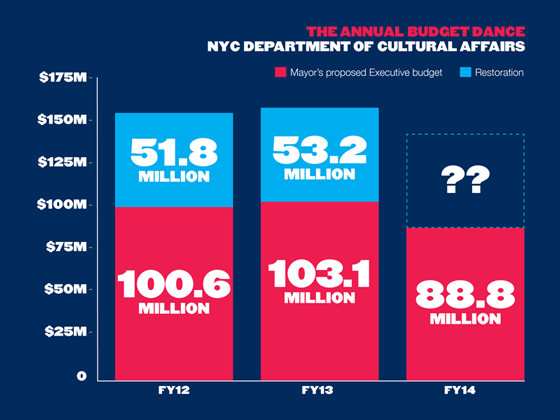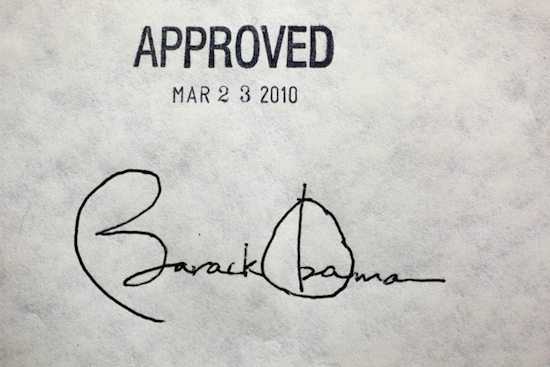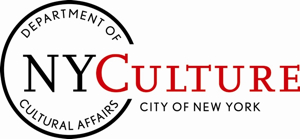|
Help Prevent NYC Department of Cultural Affairs FY14 Budget Cuts |

Two weeks ago, Mayor Bloomberg released his FY14 Executive Budget, which reflected continued cuts to the Department of Cultural Affairs! If these funds are not restored, a total of $67,484,973 will be cut from the Department of Cultural Affairs (DCLA) from the adopted budget in FY13, with $23,098,123 being cut from programs. The Cultural Institutions Group stands to lose $44,386,850 in funding.
As always, we want to urge you to contact your City Council member where you live AND where you work, and ask them to restore full funding for DCLA once more. Tell them that your companies are in the schools, the senior centers, and their neighborhoods. Remind them that when the arts suffer, so do New York City's local businesses.
Help us get these valuable dollars restored! Here are ways that you can make your voice heard:
- Write or visit your City Council Member where you live and where you work and ask them to RESTORE THE FUNDING to the New York City Department of Cultural Affairs! I cannot emphasize enough how important it is to send letters AND to make a face-to-face appearance. Ask your board members who are registered voters in New York City to visit their Council Members as well.
- Make sure that everyone who visits or writes their Council Members can share this economic impact data, prepared by A.R.T./New York:
|
New York City's 375 nonprofit theatres reach
|
8,812,360
theatergoers
|
|
Using conservative estimates, we determined the following:
|
|
|
Total amount spent at local restaurants
|
$ 154,016,940
|
|
Total amount spent on parking
|
$ 45,218,862
|
|
Total amount spent on taxi fare
|
$ 65,387,711
|
|
Total amount spent on subway fare
|
$ 44,061,800
|
|
Grand total contributed to City's economy annually
by NYC nonprofit theatres
|
$ 308,685,313
|
- If you have a vendor (printer, graphic designer, restaurant owner) who is willing to write a letter or attend a visit with you to your Council Member, please have them do so! Their support carries tremendous weight because they reinforce our message that the arts are a vital part of New York City's economy, and these cuts would be devastating.
- Do you have a story to tell about how your company has worked in the community? Do you have a particularly great partnership with a local business? We want to hear about it! Email your stories to [email protected].
We cannot afford to sit this one out and hope that other groups will do our work for us. We need a strong showing of letters and visits to Council Members.
There will be a joint hearing of the Committee on Cultural Affairs, Libraries and International Intergroup Relations (along with the Finance Committee and the Select Committee on Libraries) on Monday, June 3 at 10:00am. Please note that the public will not be able to testify at the June 3 hearing before the Committee on Cultural Affairs. Libraries will testify that day at 10:00am and then Commissioner Levin is scheduled to testify at 11:30am. The public will be allowed to testify on June 5 at 3:30pm after the Department of Finance, the Comptroller, and the Independent Budget Office testify starting at 1:00pm. Last year it was nearly impossible to get inside the building to testify. For this reason, we are urging members to mail prepared testimony to City Council Finance Committee Chair Domenic Recchia, 250 Broadway, Suite 1785, New York, NY 10007.
If you have any questions, feel free to contact Executive Director Ginny Louloudes at (212) 244-6667 ext. 228 or [email protected].
|
|
The Patient Protection and Affordable Care Act Explained |

There is an incredible amount of information floating around regarding the Health Care ruling passed down by the Supreme Court in June 2012. We compiled the best resources we had found in to a single resource for quick and easy answers to questions.
The official name is the Patient Protection and Affordable Care Act, but it will be hereafter referred to as the ACA. The bill was signed in to law on March 23, 2010, and is halfway through its four-year “roll out” period. The roll out period is a comprehensive four-year schedule of when certain aspects of the bill are put in to effect. You can view this timeline at www.healthcare.gov/law/timeline. The ACA contains nine titles (or chapters), each addressing a major area of reform:
- Quality, Affordable Care for All Americans
- The Role of Public Programs
- Improving the Quality and Efficiency of Health Care
- Prevention of Chronic Disease and Improving Public Health
- Health Care Workforce
- Transparency and Program Integrity
- Improving Access to Innovative Medical Therapies
- Community Living Assistance Services and Supports
- Revenue Provisions
To review a synopsis and key points of one of these titles, you can download a PDF summary or review key points regarding Rights and Procedures, Employers, Over Age 65, Insurance Choices and Concerns at www.healthcare.gov/law/features. Alternately, the full text of the law is available at housedocs.house.gov.
Most recently, the law was brought before the Supreme Court in order to determine whether or not it was constitutional. In a ruling at the end of June, the Supreme Court voted 5-4 that the law was constitutional, that the financial penalty on Americans that did not have health insurance should be considered a tax, and that a tax is constitutional. The only portion of the law not upheld by the Supreme Court is with regard to Medicaid and Medicare; the court ruled that the expansion of both of those programs is optional on a state-by-state basis. This means that states can or cannot implement them as they see fit. Comprehensive reporting about the rulings can be found online at nytimes.com and wsj.com.
The ACA will mean completely different for every business and for every person. To look into how it will impact you personally or in the workplace, you can refer to this online tool, which is broken down by demographic.
Whether this is a positive or negative policy is dependent entirely on who you ask. The Wall Street Journal published a feature about two entrepreneurs making the case for an opposite side. The impact will be determined entirely by a multitude of factors, including but not limited to age, state of residence, and income.
Lastly, a large part of understanding the policy is understanding the history behind it. The independent investigative journalism website, ProPublica, has compiled a reading list of relevant articles and the links to read them. They also designed a very informative flow chart, mapping the answers to the most common questions.
|
|
|
New York City FY12 Budget Update |

Dear Members,
Please read the budget update below from our government relations consultants Claudia Wagner and Adam Rich.
While the message below gives "hope" that the City Council will endeavor to restore funding to the New York City Department of Cultural Affairs (DCLA), we should not take this for granted. Since the Council is trying to sign a deal with the Mayor by 6/14 (which could change) we need your help ASAP.
STEPS YOU CAN TAKE TO HELP US SECURE DCLA RESTORATION
-
If you have a show running please download this letter and insert it in your programs tonight and/or tomorrow night. Pre-show curtain speeches urging audience members to participate, and/or assigning a staff member or volunteer to stand in the lobby to collect and distribute letters will increase your response rate.
-
If you do not have a show running, please get your staff, and anyone else you can to sign the letter TODAY. Please note, only NYC Residents should sign the letter.
MAIL ALL OF THE LETTERS IMMEDIATELY TO:
Honorable Christine Quinn, Speaker
New York City Council
250 Broadway, Suite 1856
New York, NY 10007
These letters will make a powerful impact and our voices will be heard!
Thank you!
Ginny Louloudes
Executive Director, A.R.T./New York
NEW YORK CITY FY12 BUDGET UPDATE
From government relations consultants Claudia Wagner & Adam Rich
After more than three weeks of testimony from agencies and the public, the New York City Council concluded its hearings on the CFY12 Executive Budget last night (June 6, 2011). Final details will now be hammered out in negotiations between the Administration and the Council, and the Council has until June 30 to vote on a final CFY12 Budget (July 1, 2011-June 30, 2012).
Though the Administration, the Council, and the Independent Budget office have slightly varying assessments of the City's fiscal condition, there is general agreement that revenues are starting to recover. However, the City will struggle this year to replace sharp losses of federal and state funds to key programs. Another perennial concern are "uncontrollable" costs: For example, in CFY12, employer contributions to the City pension system will increase by 20 percent (about $1.4 billion) over last year's level. Additionally, while the Mayor has presented a budget that is in balance for CFY12, the City is projecting a CFY13 budget gap of more than $3 billion.
In the last few months, the Council has identified several of the Mayor's proposed cuts it would like to restore, including proposed teacher layoffs, elimination of day care slots, firehouse closures, and cuts to the libraries and cultural organizations. The key questions in the coming days will be: how much money the City Council will have to distribute, how much it will dedicate to these priorities, and how much will be left over for other restorations and spending. The general consensus among the Council Members is that there will less "discretionary" funds for CFY12 than was available for CFY11.
The Capital budget received less focus during the Council hearings, and it is unclear how much new Capital funding, if any, will be available.
The City Council's Budget Negotiating Team (BNT) and the various borough delegations will start meeting regularly now to finalize Council spending priorities.
We will keep you apprised of developments.
|
|
NYSCA Advocacy Update: March 8, 2011 |

On Tuesday, February 8, advocates from across the state went to Albany for Arts Day. We let the legislators know that Governor Cuomo's recommended $5.6 million cut to the NYSCA was too drastic. A.R.T./New York's Ginny Louloudes and playwright Rogelio Martinez joined the NYC Arts Coalition to visit 94 Assembly and Senate members from NYC. Many were startled to see the level of proposed cuts to NYSCA, and some pledged to help.
WHAT YOU CAN DO
FAX or write your State Assembly Members and State Senators. A sample letter can be found below. We have been told that faxes and letters make a greater impact than emails.
-
To find out who your State Senator is go to http://www.nysenate.gov.us For the Assembly: http://www.assembly.state.ny.us. Unfortunately, some of these sites do not give fax numbers.
-
Please ask your friends, family, and colleagues who share your love of the arts to do the same.
SAMPLE LETTER
To: Honorable ________ NY State Assembly Member/NY State Senator
From: ____________________________________________________________
Name Address
I am a Patron of the Alliance of Resident Theatres/New York (A.R.T./New York) and attend many not-for-profit arts events in New York State.
If Governor Cuomo wants to reduce the State Budget Deficit, why is he proposing a $5.6 million cut to the New York State Council on the Arts?
-
For very dollar spent on the arts, another dollar goes into the NEW YORK STATE ECONOMY. Governor Cuomo’s cut to NYSCA would cost New York State 11.2 MILLION.
(Source, ARTS as an Industry: Their Economic Impact on New York City and New York State Alliance for the Arts, 2007)
-
In 2009, 19 Million Domestic and Foreign Cultural Visitors to New York spent $18 Billion in NYC
(Source: NYC & Co.)
-
NYSCA cuts result in lost jobs. They hurt small business, from restaurants, parking garages, real estate, advertising, lumber yards, dry cleaners, AND REDUCE STATE PAYROLL TAXES
IS THIS THE WAY TO HELP NEW YORK STATE ACHIEVE ITS POTENTIAL?
RESTORE $ 2.8 MILLION TO THE NEW YORK STATE COUNCIL ON THE ARTS!
|
|






